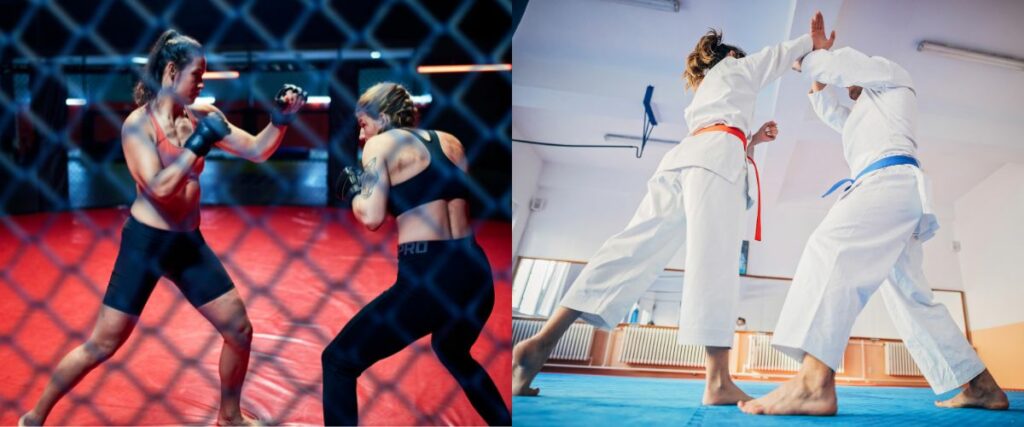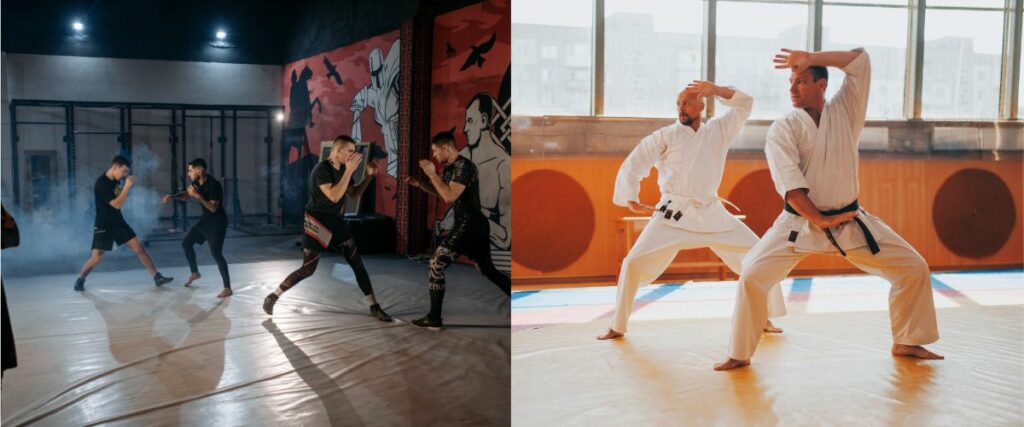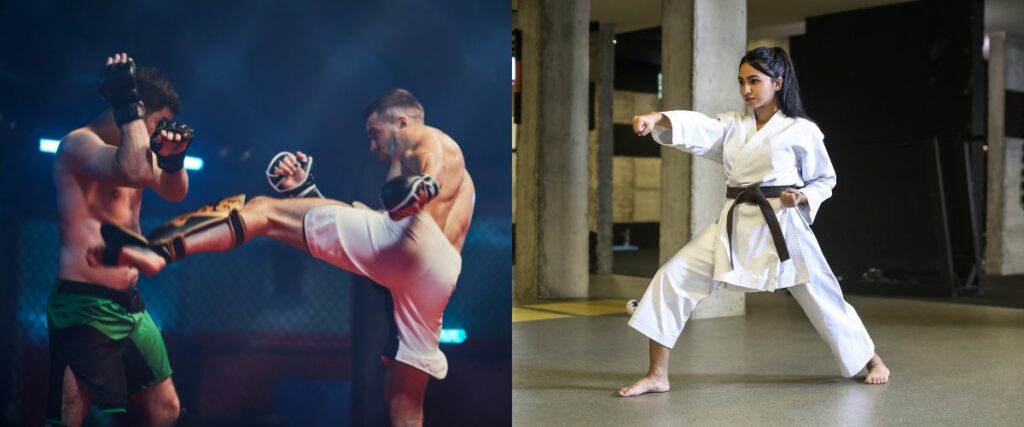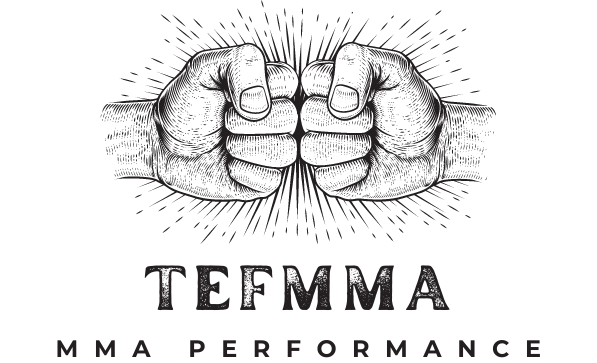Mixed martial arts and karate are extremely popular martial arts with millions of practitioners worldwide. While there are a lot of overlapping concepts, there are also some glaring differences. But do you know what they are?
MMA is a combat sport with a strong emphasis on competition and prizefighting. It combines different martial arts into a very liberal full-contact ruleset. Karate is a martial art developed for self-defense, focusing on self-development first and competitions second.
These two sentences will hardly capture the vast worlds of karate and MMA, so we analyze all the details that the two martial arts share and differ.
What Is MMA
MMA stands for “mixed martial arts” and is a full-contact combat sport. It combines techniques from other martial arts and combat systems that you can use effectively under the ruleset. This allows striking with all limbs, wrestling, grappling and fighting on the ground.
Throughout history, and especially since the beginning of the 20th century, there have been many attempts to test in practice which martial art will prevail in a fight with other styles. MMA is the modern and most advanced version of that search.
While early MMA fights were true style vs. style battles, in time, fighters began to adapt and learn many different skills, and today MMA has its own distinct style. Techniques are taken from other styles but modified to work in an actual MMA fight.
Many people practice MMA for health, fitness, and self-defense skills, but the main focus of the sport is prizefighting. Today’s sport shares the top spot with boxing as the two most viewed combat sports worldwide. MMA fighters become stars worldwide, the biggest of whom even transcend the sporting world to become celebrities.
What Is Karate
Karate is a Japanese self-defense system that focuses on self-development in the physical and mental realms. It is important to understand that many different karate styles take very different approaches to fighting. The name “karate” unifies all despite substantial differences between styles.
Most karate styles focus solely on striking with the hands and feet; some add knees and elbows, while others may include some light form of grappling.
While the main focus is self-development, almost all styles have well-developed competition. The competitions’ rules determine many of the training specifics, which techniques get more attention, and which are left in the history books.
Many styles, such as the most popular Shotokan style, emphasize light contact sparring and competition while focusing on precision and technique.
The other branch of karate led by the Kyokushin style is full-contact karate, which is more similar to combat sports like kickboxing and Muay Thai, although without strikes to the head.
MMA vs. Karate Key Differences

We will take them individually to better illustrate the key differences between MMA and karate.
Origins
As with most other traditional martial arts, karate was developed as a system for unarmed self-defense. The early forms of Karate can be traced back to the 14th century in Japan, which was heavily influenced by Chinese martial arts.
The home of karate was Okinawa Island, but once Japan conquered the kingdom, karate masters started spreading on the mainland. Karate experienced rapid development in the early twentieth century. Different masters took different approaches to the martial art, creating distinct styles that grew further apart over time.
MMA is much newer. Even though there have been many instances of mixed rules fights throughout the 20th century, Vale Tudo in Brazil was the first organized forefather of MMA.
The first official MMA organization was Shooto in Japan, established in 1986, but what skyrocketed MMA into mainstream success was the UFC. Their first event was held in 1993, and the sport gradually evolved into what we know today by the early 2000s.
Rules
MMA has the most liberal ruleset of all sanctioned combat sports. It allows striking with all body parts except the head, all kinds of wrestling, submissions, painful positions on the ground, and strikes on the ground.
A match can be won by knockout, submission, technical stoppage, or a judge’s decision. Most MMA bouts are fought in a cage, which plays a vital role in tactics. A ring can also be used, but it is far from ideal because it gets in the way of scrambles and many positions on the ground.
Karate, as we mentioned, has many styles and almost as many different rule sets. To narrow things down, we can divide it into two distinct styles: sports-type karate and full-contact karate. Shotokan-style (sports karate) competitions, which also made their way to the 2020 Olympics, do not allow and even penalize full-contact strikes.
The aim of the match is to score more points than the opponent. Once a successful technique is landed, the action is stopped, the points are awarded, and the action resumes. Think of it as a fencing competition with punches and kicks.
Full contact styles like Kyokushin karate, also called knockdown karate, allow full power strikes and do not use a point system. The difference here is that no punches to the head are allowed, but kicks and knees are. This creates a fast-paced, close-range, full-contact fighting style.
Techniques

MMA techniques are taken from each martial art. The rules allow for many individual expressions, and new techniques and strategies are always used. In the standup portion of MMA fights, you can see boxing punches, Muay Thai knees and elbows, karate kicks, TKD techniques, and much more.
Wrestling, judo, and BJJ are the most commonly used martial arts when things get up close. But as stated above, you must modify each move taken from somewhere to account for all the dangers present in an MMA fight, which are often absent in the original sport.
Karate has just as many techniques in its arsenal, but they are rarely used. The traditional forms of karate had strikes with every part of the body, takedowns, ground techniques, and even some form of weapons training.
Most of these are still referenced in Kihon (forms training) but not in actual sparring or competition. Almost all karate styles are pure striking systems with punches and kicks. Some allow knees. Others don’t. Some styles may also allow a takedown, sweep, and a single attack afterward.
Ranking and Hierarchy
A key element in karate is hierarchy and tradition. The Japanese people, in general, are very invested in their culture and traditions, which is evident in their martial arts. The rank in karate is signified by a colored belt used to hold the top part of the uniform, called a gi or a kimono.
In traditional styles and dojos, belts are awarded only after grueling tests where you must fulfill all the requirements. Higher ranked black belts can also be awarded for merits towards the martial art. Hierarchy in karate is important and strictly followed.
Like other western combat sports, MMA does not have a ranking system for practitioners. Sanctioning bodies often use some criteria to ensure that competitors are relatively equal in skill and experience. Still, individual decisions vary from country to country and organization to organization.
Generally, karate follows a structure well-established within every style and is similar everywhere you go. On the other hand, MMA has no such thing, and the ethos can be different in every gym.
MMA vs. Karate For Self-Defense

Despite what you may hear or read, there is no better martial art for unarmed self-defense than MMA (outside of combat sambo and Kudo, perhaps).
The sheer variety of techniques and training in all three fighting domains, combined with the competitive and hard nature of the sport, make it excellent for real-life fighting because it prepares both the body and mind for real violence. Of course, there are many limitations to MMA as a sport.
To be truly prepared for a real-life altercation, it is best to practice real-life scenarios in a setting different from a typical MMA session.
Karate was created as a self-defense system, and each style contains all aspects of fighting in its technique training, called Kihon. But these techniques are usually only used as an exercise against the air, making them unusable in real situations.
The focus of most karate academies is sports competitions. In the case of sport karate, it is divorced from actual fighting. It can even teach some terrible habits (like pulling your punches without full contact).
This makes MMA superior to karate for self-defense. Still, against an untrained person, a karate practitioner should have the upper hand.
Full-contact styles fare much better in real fights simply because those karatekas are used to receiving and delivering full-power strikes. Still, the absence of strikes to the head makes them very susceptible to that on the street.
There are still karate academies that have yet to abandon their initial purpose and will train and drill various self-defense techniques. If practiced realistically, it can be highly effective in the real world.
MMA vs. Karate For Fitness
Both karate and MMA are excellent full-body workouts with huge benefits for overall fitness. The ground fighting in MMA, the non-stop action, and the longer rounds require more physical attributes making strength and conditioning training an integral part of MMA.
This means you will build more muscle and have outstanding cardio. The downside is that even if practiced without competition, MMA can be grueling, and injuries are inevitable, as are a few bumps and bruises.
Karate is gentler in nature and might be more beneficial for your overall health. Karate also includes physical training, though more in bodyweight exercises. You will build flexibility, strength, endurance, and great balance in the dojo.
The physique you need is different than in MMA, but you can be confident that with the proper training, you can be in great shape regardless of which of the two you choose.
Are There MMA Fighters That Use Karate?
Karate has had its fair share of success in the cage. After the initial run of karatekas was not very good, later generations have found a way to translate their skills to MMA to significant effect. There have been a lot of MMA fighters with a karate background.
Still, Lyoto Machida was one of the first to become a champion fighting in a “karate way.” Other prominent karate fighters in MMA are Stephen “Wonderboy” Thompson, Michal “Venom” Page, and Kyoji Horiguchi.
Their success with the specific stance and strikes from karate has opened the way for many more fighters. Like Connor McGregor and Uriah Hall, to name a couple, adopted karate techniques without having a strict karate background.
MMA Fighter vs. Karate Master Who Would Win?
The fewer rules there are, the higher the chance of an MMA fighter winning. Whereas karate generally has a holistic approach to life, MMA is all about effectiveness. So, naturally, MMA is more effective than karate in a fight.
With that said, karate is an important part of MMA and is an excellent martial art in its own right, with vast benefits not found in mixed martial arts. But in a one-on-one fight, MMA wins every time.
